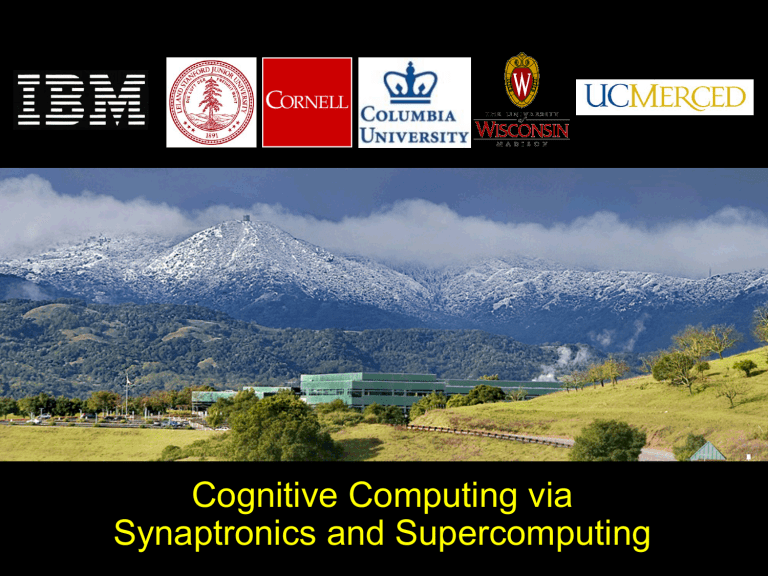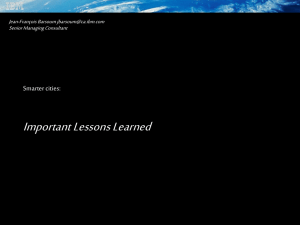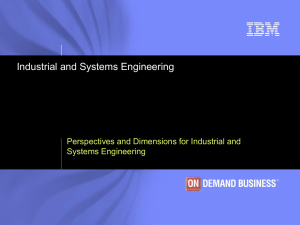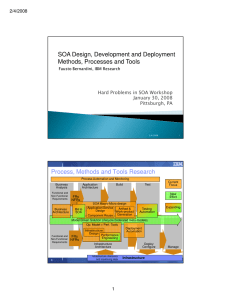Cognitive Computing via Synaptronics and Supercomputing © 2008 IBM Corporation

Cognitive Computing via
Synaptronics and Supercomputing
© 2008 IBM Corporation
"The information that comes from deep in the evolutionary past we call genetics. The information passed along from hundreds of years ago we call culture. The information passed along from decades ago we call family, and the information offered months ago we call education. But it is all information that flows through us. The brain is adapted to the river of knowledge and exists only as a creature in that river. Our thoughts are profoundly molded by this long historic flow, and none of us exists, self-made, in isolation from it."
© 2008 IBM Corporation
Inflection Point 1:
Neuroscience has matured
1414 pages
© 2008 IBM Corporation
Inflection Point 2:
Supercomputing meets Brain
© 2008 IBM Corporation
Mammalian-scale simulation in near real-time?
Memory Computation
Communication
© 2008 IBM Corporation
BlueGene Meets Brain
Mouse
N: 16 x 10 6
S: 128 x 10 9
Rat
56 x 10 6
448 x 10 9
Cat
763 x 10 6
6.1 x 10 12
Monkey
2 x 10 9
20 x 10 12
Human
22 x 10 9
220 x 10 12
New results for SC09
Almaden
BG/L
December, 2006
Watson
BG/L
April, 2007
WatsonShaheen
BG/P
March, 2009
LLNL Dawn
BG/P
May, 2009
Latest simulations achieve unprecedented scale of
10 9 neurons and 10 13 synapses
© 2008 IBM Corporation
Inflection Point 3:
Nanotechnology meets Brain
© 2008 IBM Corporation
Power
Space
Rat
50 mW
6 cm 2
Human
20 W
2,400 cm 2
Novel non-von Neumann Architectures are necessary
Brain
~10 10 synapses/cm 2
Data from Todd Hylton
Neuromorphic Electronics
10 10 intersection/cm 2 in 100 nm crossbar
~10 6 Neurons/cm 2 ~5x10 8 transistors/cm 2 in state of the art CMOS
~5 x 10 8 long range axons @ ~1 Hz
~30 Gbit/sec multiplexed digital addressing
Brain can be realized in modern electronics
© 2008 IBM Corporation
Turning Back the Clock
Digital, synchronous conventional, 5GHz
(compare Power 6 , 2008)
Digital, semi-synchronous, 5 MHz
(compare IBM PC/8088 , 1978)
Digital, asynchronous, 100 kHz
(compare ENIAC , 1946)
Digital-Analog, asynchronous, clockless
(compare the Brain )
Commandment:
Do what is necessary, when it is necessary, and only that which is necessary.
© 2008 IBM Corporation
Dharmendra S Modha
IBM Research – Almaden
Raghavendra Singh
IBM Research – India
Network Architecture of the
White Matter Pathways in the Macaque Brain
PNAS (July 2010)
© 2008 IBM Corporation
The connection model
Cortex has evolved such that it is organized into areas with distinct structural and functional properties
•
•
•
Primary sensory areas
Association areas
Motor areas
The white matter (myelinated nerve cell) underneath the outer covering of gray matter (nerve cell bodies), interconnects different regions of the central nervous system and carries nerve impulses between neuron
Model each area as a node and each connection as an edge in a graph
– Analysis and Visualization of the brain
•
• Wire length minimization
Organizational model that suggest the flow of information from input of sensory signals to the eventual output by motor neurons
– Use model to simulate dynamics in the simulator
© 2008 IBM Corporation
CoCoMac: Connectivity data on the Macaque brain
Rolf Kotter, Klass Stephen, 2000
413 literature reports
7007 brain sites
8003 mapping details
2508 tracer injections
39748 connection details
© 2008 IBM Corporation
Divergent Nomenclature and Abundant Conflicts
FV91-V1
AP84-TE
PG91b-IT
FV91-V4
BP82-46
SP89a-46
FV91-TF
RV99-TF
FV91-TH
BR98-TH
RV99-CA1
BR98-CA1
כ כ
PFCd
=
9
CCa
=
כ
PCi
=
24c
=
24
=
כ
24d
=
IPL
=
24c
=
PF#1
=
CMAr
7b
© 2008 IBM Corporation
© 2008 IBM Corporation
© 2008 IBM Corporation
© 2008 IBM Corporation
© 2008 IBM Corporation
© 2008 IBM Corporation
© 2008 IBM Corporation
© 2008 IBM Corporation
© 2008 IBM Corporation
© 2008 IBM Corporation
© 2008 IBM Corporation
Bundling Algorithm by Holten, 2006
© 2008 IBM Corporation
© 2008 IBM Corporation
© 2008 IBM Corporation
© 2008 IBM Corporation
Kaiser, Hilgetag, 2006
© 2008 IBM Corporation
Notable Collations
Species Study
Monkey Felleman, Van Essen, 91
Cat
Young, 93
Kaiser, Hilgetag, 06
Scannell et al., 95
Scannell et al., 99
Areas Connections
32 305
70
95
65
95
700
2,402
1,139
1,500
© 2008 IBM Corporation
Notable Collations
Species Study
Monkey Felleman, Van Essen, 91
Young, 93
Kaiser, Hilgetag, 06
Cat Scannell et al., 95
Scannell et al., 99
Monkey This Collection
Areas Connections
32 305
70
95
65
95
383
700
2,402
1,139
1,500
6,602
© 2008 IBM Corporation
© 2008 IBM Corporation
Cingulum Bundle
© 2008 IBM Corporation
Uncinate Fasciculus
© 2008 IBM Corporation
C, C, C, C, C, and C
Complete Cortex, Thalamus, Basal Ganglia
Comprehensive Includes every study in CoCoMac
Consistent Every connection can be tracked back
Concise
Coherent
Colossal
6,877 areas to 383
Unified hierarchical parcellation
3 times larger than previous network wetware to software
© 2008 IBM Corporation
Aggregate Statistics
Nodes
Edges
383
6,602
Density 4.5% of possible connections exist
Reciprocity 42%
SCC 351 areas, 6,491 edges
© 2008 IBM Corporation
Diameter
Brain is small-world
SCC: 351 areas, 6,491 connections
Brain
6
Random
(100 trials)
3.93
Characteristic Path Lengh 2.62
2.30
Average Clustering Coefficient
0.33
0.0528
Reciprocity
42% 5.34%
© 2008 IBM Corporation
“Organized Complexity” – Weaver, 1948
© 2008 IBM Corporation
Degree Distribution Consistent with Exponential
© 2008 IBM Corporation
Prefrontal Cortex is Topologically Central
© 2008 IBM Corporation
© 2008 IBM Corporation
Brain is small-world, Core is “tiny”-world!
Brain Core
Diameter 6 4
Characteristic Path Lengh 2.62
1.95
Average Clustering Coefficient
0.33
0.39
Core contains only 32% of vertices yet 88% of all edges originate or terminate in the core
© 2008 IBM Corporation
Core contains correlated-anti-correlated networks and may be a key to consciousness
Fox, Snyder, Vincent, Corbetta, Van Essen, and Raichle, 2005
© 2008 IBM Corporation
Inter-chip Connectivity
© 2008 IBM Corporation
Rent ’s Rule
Rent's rule pertains to the organization of computing logic, specifically the relationship between the number of external signal connections (C) to a logic block with the number of logic gates (N) in the logic block
E.F. Rent observed a powerlaw relationship in the 1960’s - the law has been shown to hold true for small circuits upto mainframe computers
C
kN p
0 ≤ p≤1 is the Rent parameter and k is the Rent coefficient.
Intrinsically it ’s a surface area (wire) to volume (number of nodes) relationship
– Represents a cost-efficient solution to the challenge of embedding a high dimensional functional interconnect topology in a relatively low dimensional physical space with economical wiring costs
–
Microprocessor (0.45), Gates Arrays (0.5), High speed Computers (0.63)
For 2D layouts p> 0.5 implies that wires must grow longer as circuit size increases; global connections dominate over local connections for large p
– The relative contribution of wiring to layout area will grow with the size of circuit to allow space for a greater number of wires to pass between adjacent nodes, increasing the node-to-node spacing
Allometric scaling
– Gray (physical) to white (logical) matter scaling - Zhang & Sejnowski
© 2008 IBM Corporation
High value of p
– Topological dimensionality of network greater than
3, i.e., greater than the dimensionality of the Euclidean space in which the network is embedded
– Communication is a significant factor of power and space
–
Tradeoff between wiring costs and greater logical capacity.
•
Rewiring the network so as to reduce its topological dimension results in loss of functional modularity
Rent ’s Rule
© 2008 IBM Corporation
© 2008 IBM Corporation
“white matter is nature’s finest masterpiece”
Nicolaus Steno, 1669
© 2008 IBM Corporation
Owing both to limitations in hardware and architecture, these (convential) machines are of limited utility in complex, real-world environments, which demand an intelligence that has not yet been captured in an algorithmiccomputational paradigm. As compared to biological systems for example, today’s programmable machines are less efficient by a factor of one million to one billion in complex, real-world environments. The SyNAPSE program seeks to break the programmable machine paradigm and define a new path forward for creating useful, intelligent machines.
The vision for the anticipated DARPA SyNAPSE program is the enabling of electronic neuromorphic machine technology that is scalable to biological levels . Programmable machines are limited not only by their computational capacity, but also by an architecture requiring (human-derived) algorithms to both describe and process information from their environment. In contrast, biological neural systems (e.g., brains) autonomously process information in complex environments by automatically learning relevant and probabilistically stable features and associations. Since real world systems are always many body problems with infinite combinatorial complexity, neuromorphic electronic machines would be preferable in a host of applications —but useful and practical implementations do not yet exist.
© 2008 IBM Corporation





